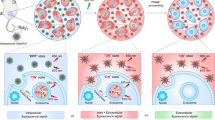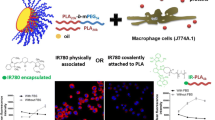ABSTRACT
Purpose
Detailed in vivo and ex vivo analysis of nanoparticle distribution, accumulation and elimination processes were combined with comprehensive particle size characterizations.
Methods
The in vivo fate of near infrared (NIR) nanoparticles in nude mice was carried out using the Maestro™ in vivo fluorescence imaging system. Asymmetrical field flow field fractionation (AF4) coupled with multi-angle laser light scattering (MALLS), photon correlation spectroscopy (PCS) and transmission electron microscopy (TEM) were employed for detailed in vitro characterization.
Results
PEG-PLA block polymers were synthesized and used for the production of defined, stable, nontoxic nanoparticles. Nanoparticle analysis revealed narrow size distribution; AF4/MALLS permitted further accurate size evaluation. Multispectral fluorescence imaging made it possible to follow the in vivo fate non-invasively even in deep tissues over several days. Detailed fluorescence ex vivo imaging studies were performed and allowed to establish a calculation method to compare nanoparticle batches with varying fluorescence intensities.
Conclusion
We combined narrow-size distributed nanoparticle batches with detailed in vitro characterization and the understanding of their in vivo fate using fluorescence imaging, confirming the wide possibilities of the non-invasive technique and presenting the basis to evaluate future size-dependent passive tumor accumulation studies.






Similar content being viewed by others
Abbreviations
- AF4:
-
asymmetrical field flow field fractionation
- CHO:
-
Chinese hamster ovary
- DiR:
-
1,1′-dioctadecyl-3,3,3′,3′-tetramethylindotricarbocyanine iodide
- EMEM:
-
Eagle’s minimum essential medium
- EPR:
-
enhanced permeability and retention
- FBS:
-
fetal bovine serum
- MALLS:
-
multi-angle laser light scattering
- MTT:
-
3-(4,5-Dimethylthiazol-2-yl)-2,5-diphenyltetrazolium bromide
- NIR:
-
near infrared
- NR:
-
nile red
- PBS:
-
phosphate-buffered saline
- PCS:
-
photon correlation spectroscopy
- PDI:
-
polydispersity indices
- QD:
-
quantum dots
- RES:
-
reticuloendothelial system
- ROI:
-
region of interest
- TEM:
-
transmission electron microscopy
REFERENCES
Brigger I, Dubernet C, Couvreur P. Nanoparticles in cancer therapy and diagnosis. Adv Drug Deliv Rev. 2002;54:631–51.
Peer D, Karp JM, Hong S, FaroKHzad OC, Margalit R, Langer R. Nanocarriers as an emerging platform for cancer therapy. Nature Nanotech. 2007;2:751–60.
Maeda H. Tumor-selective delivery of macromolecular drugs via the EPR effect: background and future prospects. Bioconjugate Chem. 2010;21:797–802.
Yuan F, Dellian M, Fukumura D, Leunig M, Berk DA, Torchilin VP, et al. Vascular-permeability in a human tumor xenograft - molecular-size dependence and cutoff size. Cancer Res. 1995;55:3752–6.
Hobbs SK, Monsky WL, Yuan F, Roberts WG, Griffith L, Torchilin VP, et al. Regulation of transport pathways in tumor vessels: role of tumor type and microenvironment. Proc Natl Acad Sci USA. 1998;95:4607–12.
Moghimi SM, Porter CJH, Muir IS, Illum L, Davis SS. Non-phagocytic uptake of intravenously injected microspheres in rat spleen - influence of particle-size and hydrophilic coating. Biochem Biophys Res Commun. 1991;177:861–6.
Moghimi SM, Hunter AC, Murray JC. Long-circulating and target-specific nanoparticles: theory to practice. Pharmacol Rev. 2001;53:283–318.
Nakaoka R, Tabata Y, Yamaoka T, Ikada Y. Prolongation of the serum half-life period of superoxide dismutase by poly(ethylene glycol) modification. J Controlled Release. 1997;46:253–61.
Litzinger DC, Buiting AMJ, Vanrooijen N, Huang L. Effect of liposome size on the circulation time and intraorgan distribution of amphipathic Poly(Ethylene Glycol)-Containing Liposomes. Biochim Biophys Acta, Biomembr. 1994;1190:99–107.
Liu DX, Mori A, Huang L. Role of liposome size and res blockade in controlling biodistribution and tumor uptake of Gm1-containing liposomes. Biochim Biophys Acta. 1992;1104:95–101.
Storm G, Belliot SO, Daemen T, Lasic DD. Surface modification of nanoparticles to oppose uptake by the mononuclear phagocyte system. Adv Drug Deliv Rev. 1995;17:31–48.
Gaumet M, Vargas A, Gurny R, Delie F. Nanoparticles for drug delivery: the need for precision in reporting particle size parameters. Eur J Pharm Biopharm. 2008;69:1–9.
Dunn SE, Coombes AGA, Garnett MC, Davis SS, Davies MC, Illum L. In vitro cell interaction and in vivo biodistribution of poly(lactide-co-glycolide) nanospheres surface modified by poloxamer and poloxamine copolymers. J Controlled Release. 1997;44:65–76.
Kwon GS, Kataoka K. Block-copolymer micelles as long-circulating drug vehicles. Adv Drug Deliv Rev. 1995;16:295–309.
Hezinger AFE, Tessmar J, Gopferich A. Polymer coating of quantum dots—A powerful tool toward diagnostics and sensorics. Eur J Pharm Biopharm. 2008;68:138–52.
Medintz IL, Uyeda HT, Goldman ER, Mattoussi H. Quantum dot bioconjugates for imaging, labelling and sensing. Nature Mater. 2005;4:435–46.
Smith AM, Duan HW, Mohs AM, Nie SM. Bioconjugated quantum dots for in vivo molecular and cellular imaging. Adv Drug Deliv Rev. 2008;60:1226–40.
Frangioni JV. In vivo near-infrared fluorescence imaging. Curr Opin Chem Biol. 2003;7:626–34.
Derfus AM, Chan WCW, Bhatia SN. Probing the cytotoxicity of semiconductor quantum dots. Nano Lett. 2004;4:11–8.
Lucke A, Tessmar J, Schnell E, Schmeer G, Gopferich A. Biodegradable poly(D, L-lactic acid)-poly(ethylene glycol)-monomethyl ether diblock copolymers: structures and surface properties relevant to their use as biomaterials. Biomaterials. 2000;21:2361–70.
Fessi H, Puisieux F, Devissaguet JP, Ammoury N, Benita S. Nanocapsule formation by interfacial polymer deposition following solvent displacement. Int J Pharm. 1989;55:R1–4.
Rose C. Particulate systems for Fluorescence Imaging and Drug Delivery. Thesis: University of Regensburg; 2010.
Kuntsche J, Klaus K, Steiniger F. Size determinations of colloidal fat emulsions: a comparative study. J Biomed Nanotechnol. 2009;5:384–95.
Westedt U, Kalinowski M, Wittmar M, Merdan T, Unger F, Fuchs J, et al. Poly(vinyl alcohol)-graft-poly(lactide-co-glycolide) nanoparticles for local delivery of paclitaxel for restenosis treatment. J Controlled Release. 2007;119:41–51.
Mosmann T. Rapid colorimetric assay for cellular growth and survival—Application to proliferation and cyto-toxicity assays. J Immunol Methods. 1983;65:55–63.
Schaffer BS, Grayson MH, Wortham JM, Kubicek CB, McCleish AT, Prajapati SI, et al. Immune competency of a hairless mouse strain for improved preclinical studies in genetically engineered mice. Mol Cancer Ther. 2010;9:2354–64.
Leblond F, Davis SC, Valdes PA, Pogue BW. Pre-clinical whole-body fluorescence imaging: review of instruments, methods and applications. J Photoch Photobio B. 2010;98:77–94.
Mansfield JR, Gossage KW, Hoyt CC, Levenson RM. Autofluorescence removal, multiplexing, and automated analysis methods for in-vivo fluorescence imaging. J Biomed Opt. 2005;10.
Zimmermann T, Rietdorf J, Pepperkok R. Spectral imaging and its applications in live cell microscopy. FEBS Lett. 2003;546:87–92.
Cheng FY, Wang SPH, Su CH, Tsai TL, Wu PC, Shieh DB, et al. Stabilizer-free poly(lactide-co-glycolide) nanoparticles for multimodal biomedical probes. Biomaterials. 2008;29:2104–12.
Putaux JL, Buleon A, Borsali R, Chanzy H. Ultrastructural aspects of phytoglycogen from cryo-transmission electron microscopy and quasi-elastic light scattering data. Int J Biol Macromol. 1999;26:145–50.
Lohrke J, Briel A, Mader K. Characterization of superparamagnetic iron oxide nanoparticles by asymmetrical flow-field-flow-fractionation. Nanomedicine. 2008;3:437–52.
Stauch O, Schubert R, Savin G, Burchard W. Structure of artificial cytoskeleton containing liposomes in aqueous solution studied by static and dynamic light scattering. Biomacromolecules. 2002;3:565–78.
Coffin MD, Mcginity JW. Biodegradable pseudolatexes—the chemical-stability of Poly(D, L-Lactide) and poly (Epsilon-Caprolactone) nanoparticles in aqueous-media. Pharm Res. 1992;9:200–5.
Dunne M, Corrigan OI, Ramtoola Z. Influence of particle size and dissolution conditions on the degradation properties of polylactide-co-glycolide particles. Biomaterials. 2000;21:1659–68.
Lin WJ, Chen YC, Lin CC, Chen CF, Chen JW. Characterization of pegylated copolymeric micelles and in vivo pharmacokinetics and biodistribution studies. J Biomed Mater Res Part B. 2006;77B:188–94.
Honig MG, Hume RI. Fluorescent carbocyanine dyes allow living neurons of identified origin to be studied in long-term cultures. J Cell Biol. 1986;103:171–87.
Texier I, Goutayer M, Da Silva A, Guyon L, Djaker N, Josserand V, et al. Cyanine-loaded lipid nanoparticles for improved in vivo fluorescence imaging. J Biomed Opt. 2009;14.
Chen J, Corbin IR, Li H, Cao WG, Glickson JD, Zheng G. Ligand conjugated low-density lipoprotein nanoparticles for enhanced optical cancer imaging in vivo. J Am Chem Soc. 2007;129:5798.
Kuffler DP. Long-term survival and sprouting in culture by motoneurons isolated from the spinal-cord of adult frogs. J Comp Neurol. 1990;302:729–38.
Weissleder R. A clearer vision for in vivo imaging. Nat Biotechnol. 2001;19:316–7.
Hardin J. Confocal and multi-photon imaging of living embryos. In Pawley JB, Masters BR, editors. Handbook of biological confocal microscopy. J Biomed Opt. 2008;760.
Jores K, Haberland A, Wartewig S, Mader K, Mehnert W. Solid lipid nanoparticles (SLN) and oil-loaded SLN studied by spectrofluorometry and raman spectroscopy. Pharm Res. 2005;22:1887–97.
Petersen S, Fahr A, Bunjes H. Flow cytometry as a new approach to investigate drug transfer between lipid particles. Mol Pharmaceutics. 2010;7:350–63.
N.n. Public Chemical Database. Public Chemical Database. 2010.
Greenspan P, Mayer EP, Fowler SD. Nile red—A selective fluorescent stain for intracellular lipid droplets. J Cell Biol. 1985;100:965–73.
Rashid F, Horobin RW, Williams MA. Predicting the behaviour and selectivity of fluorescent probes for lysosomes and related structures by means of structure-activity models. Histochem J. 1991;23:450–9.
Rashid F, Horobin RW. Interaction of molecular probes with living cells and tissues.2. A structure-activity analysis of mitochondrial staining by cationic probes, and a discussion of the synergistic nature of image-based and biochemical approaches. Histochem Cell Biol. 1990;94:303–8.
Ivanov AI, Gavrilov VB, Furmanchuk DA, Aleinikova O, Konev SV, Kaler GV. Fluorescent probing of the ligand-binding ability of blood plasma in the acute-phase response. Clin Exp Med. 2002;2:147–55.
Gordon S, Tee RD, Taylor AJN. Analysis of rat urine proteins and allergens by sodium Dodecyl-Sulfate Polyacrylamide-Gel electrophoresis and immunoblotting. J Allergy Clin Immun. 1993;92:298–305.
Lim HJ, Parr MJ, Masin D, McIntosh NL, Madden TD, Zhang GY, et al. Kupffer cells do not play a role in governing the efficacy of liposomal mitoxantrone used to treat a tumor model designed to assess drug delivery to liver. Clin Cancer Res. 2000;6:4449–60.
Bazile D, Prudhomme C, Bassoullet MT, Marlard M, Spenlehauer G, Veillard M. Stealth Me.Peg-Pla nanoparticles avoid uptake by the mononuclear phagocytes system. J Pharm Sci. 1995;84:493–8.
Verrecchia T, Spenlehauer G, Bazile DV, Murrybrelier A, Archimbaud Y, Veillard M. Non-stealth (Poly(Lactic Acid Albumin)) and stealth (Poly(Lactic Acid-Polyethylene Glycol)) nanoparticles as injectable drug carriers. J Controlled Release. 1995;36:49–61.
Gref R, Miralles G, Dellacherie E. Polyoxyethylene-coated nanospheres: effect of coating on zeta potential and phagocytosis. Polym Int. 1999;48:251–6.
ACKNOWLEDGMENTS
Jörg Teßmar is acknowledged for the discussions during the polymer synthesis and nanoparticle preparation steps. We also thank also Anna Hezinger for the help with the TEM measurements and Martina Hennicke and Constanze Gottschalk for taking care of the animals. Parts of the studies were supported by grants from the Federal State of Saxony Anhalt (FKZ 3646A/0907).
Author information
Authors and Affiliations
Corresponding author
Rights and permissions
About this article
Cite this article
Schädlich, A., Rose, C., Kuntsche, J. et al. How Stealthy are PEG-PLA Nanoparticles? An NIR In Vivo Study Combined with Detailed Size Measurements. Pharm Res 28, 1995–2007 (2011). https://doi.org/10.1007/s11095-011-0426-5
Received:
Accepted:
Published:
Issue Date:
DOI: https://doi.org/10.1007/s11095-011-0426-5




